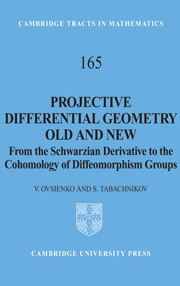 Projective Differential Geometry Old and New
Projective Differential Geometry Old and New Book contents
- Frontmatter
- Contents
- Preface: why projective?
- 1 Introduction
- 2 The geometry of the projective line
- 3 The algebra of the projective line and cohomology of Diff(S1)
- 4 Vertices of projective curves
- 5 Projective invariants of submanifolds
- 6 Projective structures on smooth manifolds
- 7 Multi-dimensional Schwarzian derivatives and differential operators
- Appendices
- References
- Index
1 - Introduction
Published online by Cambridge University Press: 14 August 2009
- Frontmatter
- Contents
- Preface: why projective?
- 1 Introduction
- 2 The geometry of the projective line
- 3 The algebra of the projective line and cohomology of Diff(S1)
- 4 Vertices of projective curves
- 5 Projective invariants of submanifolds
- 6 Projective structures on smooth manifolds
- 7 Multi-dimensional Schwarzian derivatives and differential operators
- Appendices
- References
- Index
Summary
… the field of projective differential geometry is so rich that it seems well worth while to cultivate it with greater energy than has been done heretofore.
E. J. WilczynskiIn this introductory chapter we present a panorama of the subject of this book. The reader who decides to restrict himself to this chapter will get a rather comprehensive impression of the area.
We start with the classical notions of curves in projective space and define projective duality. We then introduce first differential invariants such as projective curvature and projective length of non-degenerate plane projective curves. Linear differential operators in one variable naturally appear here to play a crucial role in what follows.
Already in the one-dimensional case, projective differential geometry offers a wealth of interesting structures and leads us directly to the celebrated Virasoro algebra. The Schwarzian derivative is the main character here. We tried to present classical and contemporary results in a unified synthetic manner and reached the material discovered as late as the last decades of the twentieth century.
Projective space and projective duality
Given a vector space V, the associated projective space, ℙ(V), consists of one-dimensional subspaces of V. If V = ℝn+1 then ℙ(V) is denoted by ℝℙn. The projectivization, ℙ(U), of a subspace U ⊂ V is called a projective subspace of ℙ(V).
- Type
- Chapter
- Information
- Projective Differential Geometry Old and NewFrom the Schwarzian Derivative to the Cohomology of Diffeomorphism Groups, pp. 1 - 25Publisher: Cambridge University PressPrint publication year: 2004
